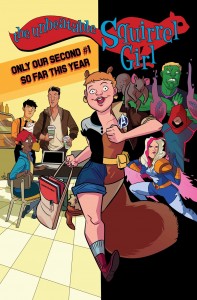 The Unbeatable Squirrel Girl #1 — Writer: Ryan North; Art: Erica Henderson; Colors: Rico Renzi
The Unbeatable Squirrel Girl #1 — Writer: Ryan North; Art: Erica Henderson; Colors: Rico Renzi
Angela: Queen of Hel #1 — Writer: Marguerite Bennett; Art: Kim Jacinto with Stephanie Hans; Colors: Israel Silva
Howling Commandos of S.H.I.E.L.D. #1 — Writer: Frank Barbiere; Art: Brent Schoonover; Colors: Nick Filardi
Marvel continues its slow rollout of new books — Squirrel Girl is definitely the star, with its irresistible combination of charm, snarky humor, girl power and clever problem-solving; it’s got the perfect creative team in North and Henderson  (just look at New Avengers, where the character is a team member, to see how hard it is for anyone else to duplicate what these two are doing here), and, really, everyone should be buying this book. Pick it up and read the first couple of pages, and see if you aren’t hooked by it: like DC’s Batgirl, it’s the sleek, kid-and-girl-friendly, glittering future of comics, right there in your hand. Angela: Queen of Hel is a modern comic, too — the LGBT-friendly relationship at its center should tell you that — but it’s otherwise very different from Squirrel Girl: dark where the former is light; serious where it’s funny (although there’s some humor too), and slow-building and mythic instead of fast-paced and ironic. It’s good, though, and it’s nice to know that Marvel’s brand-new universe has room for them
(just look at New Avengers, where the character is a team member, to see how hard it is for anyone else to duplicate what these two are doing here), and, really, everyone should be buying this book. Pick it up and read the first couple of pages, and see if you aren’t hooked by it: like DC’s Batgirl, it’s the sleek, kid-and-girl-friendly, glittering future of comics, right there in your hand. Angela: Queen of Hel is a modern comic, too — the LGBT-friendly relationship at its center should tell you that — but it’s otherwise very different from Squirrel Girl: dark where the former is light; serious where it’s funny (although there’s some humor too), and slow-building and mythic instead of fast-paced and ironic. It’s good, though, and it’s nice to know that Marvel’s brand-new universe has room for them 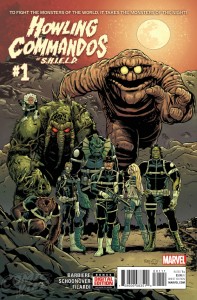 both. There’s also Howling Commandos of S.H.I.E.L.D. — an appropriate book for this week, since it’s basically a monster team-up: Dum Dum Dugan (or, rather, a sentient-LMD version of him) leading the Man-Thing, Manphibian, a woman vampire, Teen Abomination, Hit-Monkey, Orrgo (one of those pre-superhero Kirby Kreatures) and a Jasper Sitwell who’s now a zombie on various missions involving the supernatural. That’s a motley crew, and neither the art nor story are outstanding enough to elevate it into a must-read hit, but if you’re a fan of any of those characters it’s got a smooth enough touch to at least make it interesting.
both. There’s also Howling Commandos of S.H.I.E.L.D. — an appropriate book for this week, since it’s basically a monster team-up: Dum Dum Dugan (or, rather, a sentient-LMD version of him) leading the Man-Thing, Manphibian, a woman vampire, Teen Abomination, Hit-Monkey, Orrgo (one of those pre-superhero Kirby Kreatures) and a Jasper Sitwell who’s now a zombie on various missions involving the supernatural. That’s a motley crew, and neither the art nor story are outstanding enough to elevate it into a must-read hit, but if you’re a fan of any of those characters it’s got a smooth enough touch to at least make it interesting.
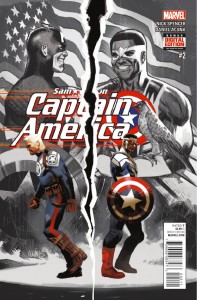 Captain America: Sam Wilson #2 — Writer: Nick Spencer; Art/Colors: Daniel Acuna
Captain America: Sam Wilson #2 — Writer: Nick Spencer; Art/Colors: Daniel Acuna
The New Avengers #2 — Writer: Al Ewing; Art: Gerardo Sandoval; Colors: Dono Sanchez Almara
Spider-Man 2099 #2 — Writer: Peter David; Art: Will Sliney; Colors: Frank D’Armata and Andres Mossa
A trio of Marvel second issues: Captain America does a good job of building on its debut, distinguishing Sam from Steve Rogers in ways that still give him a good reason to wear the red-white-and-blue, and  tackling current issues — illegal immigration, an Edward Snowden-like figure — in ways that are logical and (mostly) even-handed. It’s still too talky — too many pages with lots of little panels — but the last-page splash suggests that, when Acuna finally gets some room to breathe, he’ll be able to deliver some decent art. New Avengers is a harder case: the second issue does itself no favors by focusing on the Ultimate Universe Reed Richards (now called “The Maker”) as its bad guy, because, c’mon, he’s been a boring bad guy in the Ultimate books for years. Ewing’s last book, Secret Avengers, was a delight, funny but tightly plotted and ultimately poignant, but
tackling current issues — illegal immigration, an Edward Snowden-like figure — in ways that are logical and (mostly) even-handed. It’s still too talky — too many pages with lots of little panels — but the last-page splash suggests that, when Acuna finally gets some room to breathe, he’ll be able to deliver some decent art. New Avengers is a harder case: the second issue does itself no favors by focusing on the Ultimate Universe Reed Richards (now called “The Maker”) as its bad guy, because, c’mon, he’s been a boring bad guy in the Ultimate books for years. Ewing’s last book, Secret Avengers, was a delight, funny but tightly plotted and ultimately poignant, but 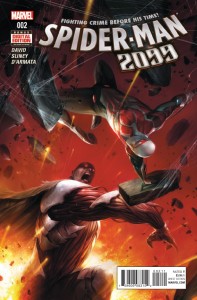 he just doesn’t quite have a handle on these characters yet — and Sandoval’s art has similar problems, mixing manga and American influences without quite committing to either. Still, there are enough flashes of quality, in both story and art, to make this worth keeping up with for another couple of issues. As with its first issue, Spider-Man 2099 is the easiest book to peg, just because it’s by the same team that produced the previous volume (and, of course, Peter David has been writing this character since his debut in the ’90s); if you liked it before, you’ll have no reason not to like it now.
he just doesn’t quite have a handle on these characters yet — and Sandoval’s art has similar problems, mixing manga and American influences without quite committing to either. Still, there are enough flashes of quality, in both story and art, to make this worth keeping up with for another couple of issues. As with its first issue, Spider-Man 2099 is the easiest book to peg, just because it’s by the same team that produced the previous volume (and, of course, Peter David has been writing this character since his debut in the ’90s); if you liked it before, you’ll have no reason not to like it now.
 Guidebook to the Marvel Cinematic Universe: Iron Man — Creators: Various
Guidebook to the Marvel Cinematic Universe: Iron Man — Creators: Various
Secret Wars: Official Guide to the Marvel Multiverse #1 — Creators: Various
These are a couple of encyclopedia/Who’s Who-style compilations, each with something to recommend it: the Iron Man is a clever conceit, giving bios and plot summaries of various characters familiar from the movies — Tony Stark, Pepper, Obadiah Stane, etc. — next to their comics versions, so that, for example, the entry on Pepper has a photo of Gwyneth Paltrow and a summary of her movie role, and then there’s a drawing of the comics Pepper and a brief summary of her role there, along with the cover of Tales of Suspense #45, her first appearance. Between the photos and the  text, it’s a decent little reference work/keepsake for fans of both versions of the characters. The Secret Wars is more like a standard Official Handbook of the Marvel Universe package, with listings for major characters from both the original Secret Wars I and II and then a number of the alternate-universe remnants that are part of Doom’s Battleworld in the current series. Presumably, many of the latter entries are there because those characters will survive into the “new” Marvel universe (Weirdworld gets three pages, as does the Spider-Verse), although the alphabetical order creates some odd pairings — the entry on “Old Man Logan” is facing a page on “Obnoxio the Clown,” for example, but one of those characters is going to be a whole lot more important than the other. Unless….? — but that’s just the kind of fannish speculation that these books were built for, and this one offers more than enough data and history to justify its $4.99 price.
text, it’s a decent little reference work/keepsake for fans of both versions of the characters. The Secret Wars is more like a standard Official Handbook of the Marvel Universe package, with listings for major characters from both the original Secret Wars I and II and then a number of the alternate-universe remnants that are part of Doom’s Battleworld in the current series. Presumably, many of the latter entries are there because those characters will survive into the “new” Marvel universe (Weirdworld gets three pages, as does the Spider-Verse), although the alphabetical order creates some odd pairings — the entry on “Old Man Logan” is facing a page on “Obnoxio the Clown,” for example, but one of those characters is going to be a whole lot more important than the other. Unless….? — but that’s just the kind of fannish speculation that these books were built for, and this one offers more than enough data and history to justify its $4.99 price.
 Secret Wars: House of M #4 (of 4) — Writer: Dennis Hopeless and Cullen Bunn; Art: Ario Anindito; Colors: Matthew Wilson
Secret Wars: House of M #4 (of 4) — Writer: Dennis Hopeless and Cullen Bunn; Art: Ario Anindito; Colors: Matthew Wilson
Secret Wars: Where Monsters Dwell #5 (of 5) — Writer: Garth Ennis; Art: Russ Braun; Colors: Dono Sanchez Almara
I think these are the last two Secret Wars tie-ins to conclude, although they’re very different: House of M involves mainstay characters like Magneto and Sub-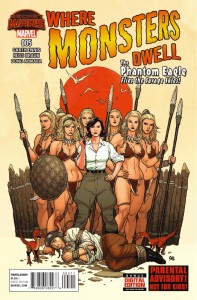 Mariner battling it out in a typical plot for these mini-series, with a reasonably-graceful (but also typical) conclusion, while Where Monsters Dwell pays no attention to any other familiar characters at all, content to tell its own tale of the former WWI ace the Phantom Eagle, but filtered through Ennis’s gimlet eye towards the kind of phony rogues who put saving their own skin ahead of any duty to comrades or country. Watching him and Braun go about their business is a lot of fun, though, and makes WMD a fitting end to all those months of alternate-world exploration.
Mariner battling it out in a typical plot for these mini-series, with a reasonably-graceful (but also typical) conclusion, while Where Monsters Dwell pays no attention to any other familiar characters at all, content to tell its own tale of the former WWI ace the Phantom Eagle, but filtered through Ennis’s gimlet eye towards the kind of phony rogues who put saving their own skin ahead of any duty to comrades or country. Watching him and Braun go about their business is a lot of fun, though, and makes WMD a fitting end to all those months of alternate-world exploration.
 Batgirl #45 — Writers: Cameron Stewart and Brenden Fletcher; Art: Babs Tarr; Colors: Serge Lapointe
Batgirl #45 — Writers: Cameron Stewart and Brenden Fletcher; Art: Babs Tarr; Colors: Serge Lapointe
All-Star Section Eight #5 (of 6) — Writer: Garth Ennis; Art: John McRea; Colors: John Kalisz
Gotham By Midnight #10 — Writer: Ray Fawkes; Art/Colors: Juan Ferreyra
Superman #45 — Writer: Gene Luen Yang; Art: Howard Porter; Colors: Hi-Fi
Justice League: The Darkseid War: Batman #1 (of 1) — Writer: Peter Tomasi; Pencils: Fernando Pasarin; Inks: Matt Ryan; Colors: Gabe 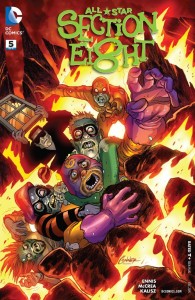 Eltaeb
Eltaeb
A handful of regular DC books — I mentioned Batgirl earlier, and this issue is a good example of its cool modern charm. Tarr has a confident combination of manga and American superhero influences that uses clear and striking panel layouts to handle action scenes, fashion, and emotive expressions with equal ease, and Lapointe’s bright colors blend with it perfectly; mix in the plot, which involves a wedding and the return of Dick Grayson (whose long scene with Barbara hits every note just right), and this is a great example of one of the best books on the stands right now. All-Star Section Eight offers nothing like that; it’s wallowing in a gutter far below Batgirl’s penthouse. That’s, oddly, not a bad  thing, because Ennis and McRea are experts in that territory, and mine it with humor and sharp satirical skill (and, in this issue, more than a little pathos, as it becomes clear that most of what’s happening is only in the mind of its hapless, accidentally-drunk main character). Like Bizarro, this book benefits from being only a six-issue series; it can tell a full story with a definite ending, without having to worry about artificially maintaining its status quo or boring readers with its over-the-top cast: like a perfect party guest, it knows just when to leave. Gotham By Midnight knows about over-the-top characters, too: last issue, it had Jim Corrigan, under aggressive questioning from two Internal Affairs agents about his Gotham Police supernatural-crimes unit, unleash The Spectre on them and…
thing, because Ennis and McRea are experts in that territory, and mine it with humor and sharp satirical skill (and, in this issue, more than a little pathos, as it becomes clear that most of what’s happening is only in the mind of its hapless, accidentally-drunk main character). Like Bizarro, this book benefits from being only a six-issue series; it can tell a full story with a definite ending, without having to worry about artificially maintaining its status quo or boring readers with its over-the-top cast: like a perfect party guest, it knows just when to leave. Gotham By Midnight knows about over-the-top characters, too: last issue, it had Jim Corrigan, under aggressive questioning from two Internal Affairs agents about his Gotham Police supernatural-crimes unit, unleash The Spectre on them and…  well, kill them. How could God’s emissary do that? What if The Spectre wasn’t a manifestation of God’s judgment at all, but instead of Corrigan’s own inner anger, fueled by his own unconscious abilities? That question leads this comic down some very dark paths, but since it’s only twelve issues long, and this is issue ten, we won’t have to wait long to see where they lead. Ferreyra’s had the unenviable job of following Ben Templesmith’s art, but he’s managed to keep the comic’s shadowy horror atmosphere, and even add his own slant to it. Superman features an artist with an unenviable job, too — Howard Porter, who has to take over the story after a year of John Romita Jr. and Klaus Janson. There’s no way it can look as good as under those two, but fortunately Porter’s been around superhero books, including
well, kill them. How could God’s emissary do that? What if The Spectre wasn’t a manifestation of God’s judgment at all, but instead of Corrigan’s own inner anger, fueled by his own unconscious abilities? That question leads this comic down some very dark paths, but since it’s only twelve issues long, and this is issue ten, we won’t have to wait long to see where they lead. Ferreyra’s had the unenviable job of following Ben Templesmith’s art, but he’s managed to keep the comic’s shadowy horror atmosphere, and even add his own slant to it. Superman features an artist with an unenviable job, too — Howard Porter, who has to take over the story after a year of John Romita Jr. and Klaus Janson. There’s no way it can look as good as under those two, but fortunately Porter’s been around superhero books, including  Justice League, a long time, so he’s able to handle Yang’s take on the depowered-Superman story without skipping too many beats. Darkseid War: Batman owes something to the Justice League, too — it’s a spinoff from that book’s Darkseid War arc which culminated, last issue, in each of the JLAers getting New-God-like qualities; now, this month, we’re getting a series of one-shots detailing how each character handles their newfound abilities and temptations, as Batman uses the Mobius Chair to access all information and become the God of Knowledge — and use that knowledge to hunt down the murderer of his parents.
Justice League, a long time, so he’s able to handle Yang’s take on the depowered-Superman story without skipping too many beats. Darkseid War: Batman owes something to the Justice League, too — it’s a spinoff from that book’s Darkseid War arc which culminated, last issue, in each of the JLAers getting New-God-like qualities; now, this month, we’re getting a series of one-shots detailing how each character handles their newfound abilities and temptations, as Batman uses the Mobius Chair to access all information and become the God of Knowledge — and use that knowledge to hunt down the murderer of his parents.
 Art Ops #1 — Writer: Shaun Simon; Art: Michael Allred; Colors: Laura Allred
Art Ops #1 — Writer: Shaun Simon; Art: Michael Allred; Colors: Laura Allred
Vertigo Quarterly: SFX: Krak! #3 — Creators: Various
Two Vertigo titles — Art Ops is as clever as its title, and posits that art is “real,” that the characters on the canvas can quit and poke out into the light, or be physically menaced by art thieves or forgers. Fortunately, the title organization is around to protect them; only Michael Allred could give justice to a plot that requires him to draw a “real” Mona Lisa and other entities, and he’s the one who makes all of this believable, right down to the “painted” fake arm of the book’s reluctant hero; anything he does is worth a look. So too for Vertigo Quarterly: SFX, an anthology title whose conceit is that every story has to have a plot element around the sound 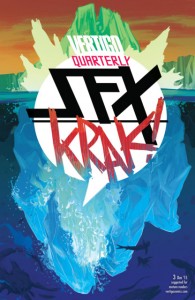 effect “Krak!” The standout here is the offering by Gilbert Hernandez (one unshakable comics rule is that he’s the standout whenever and wherever he chooses to publish anything), but there’s also work by the seldom-seen and always-amazing Peter Kuper, by the equally-unique Jen Wang, and also by Mark Buckingham (assisted by Jessica Martin), Nathan Fox, Ming Doyle (over a script by Ryan Burton), and three or four others. Not all of these efforts hit, or stick, but most of them do, and the readers get to see a bunch of top-tier talents they might never encounter otherwise, all for the price of two regular mainstream books.
effect “Krak!” The standout here is the offering by Gilbert Hernandez (one unshakable comics rule is that he’s the standout whenever and wherever he chooses to publish anything), but there’s also work by the seldom-seen and always-amazing Peter Kuper, by the equally-unique Jen Wang, and also by Mark Buckingham (assisted by Jessica Martin), Nathan Fox, Ming Doyle (over a script by Ryan Burton), and three or four others. Not all of these efforts hit, or stick, but most of them do, and the readers get to see a bunch of top-tier talents they might never encounter otherwise, all for the price of two regular mainstream books.
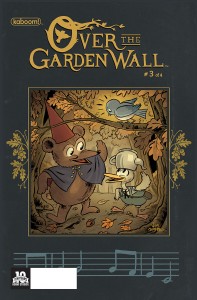 Over the Garden Wall #3 (0f 4) — Writer: Pat McHale; Art: Jim Campbell; Colors: Jim Campbell with Danielle Burgos
Over the Garden Wall #3 (0f 4) — Writer: Pat McHale; Art: Jim Campbell; Colors: Jim Campbell with Danielle Burgos
Rick and Morty #7 — Writer: Zac Gorman; Art: CJ Cannon; Colors: Ryan Hill
Two… well, not quite “kids’ comics,” but books based on cartoons. Over the Garden Wall is from the Cartoon Network mini-series from about a year ago, about two brothers lost in an enchanted woods; in lesser hands that could be a really sugary, twee concept, but McHale, who created the original series and writes this comic, too, keeps it grounded, with 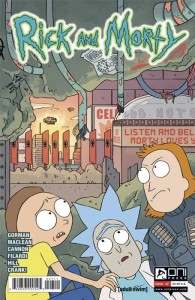 the kids acting like actual kids and the plot moving in unexpected directions. It’s one of those books that looks like it’ll be nothing, and then ends up drawing you into its world and making you want more. Rick and Morty is definitely not for kids, at least little ones; both the book and the cartoon earn their Adult Swim status with their drunken, perpetually-addled protagonist, their sophisticated multiversal plots and Kevin Smith-like pop-culture references, and their casual, startling violence. Those are all strengths, mind you, and this issue, which begins an arc involving someone trying to kill all the dimensional versions of the two title characters, is a great introduction to them.
the kids acting like actual kids and the plot moving in unexpected directions. It’s one of those books that looks like it’ll be nothing, and then ends up drawing you into its world and making you want more. Rick and Morty is definitely not for kids, at least little ones; both the book and the cartoon earn their Adult Swim status with their drunken, perpetually-addled protagonist, their sophisticated multiversal plots and Kevin Smith-like pop-culture references, and their casual, startling violence. Those are all strengths, mind you, and this issue, which begins an arc involving someone trying to kill all the dimensional versions of the two title characters, is a great introduction to them.
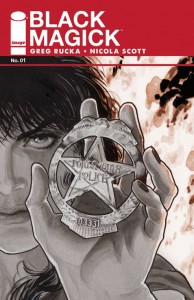 Black Magick #1 — Writer: Greg Rucka; Art: Nicola Scott; Colors: Nicola Scott with Chiara Arena
Black Magick #1 — Writer: Greg Rucka; Art: Nicola Scott; Colors: Nicola Scott with Chiara Arena
Stumptown #8 — Writer: Greg Rucka; Art: Justin Greenwood; Colors: Ryan Hill
Two by Rucka: Black Magick is a female cop who’s also a Wiccan, and very competent at both of her jobs; it sounds like the kind of high-concept pitch that could end up flat and stupid, but fortunately Rucka, like Ed Brubaker, is adept at combining realistic police procedurals with supernatural/occult elements, and so this first issue offers a smooth, entertaining, 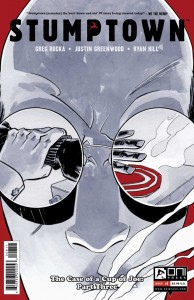 action-packed introduction to the character that, especially with Scott’s beautifully-detailed art and some subtle coloring effects, is a textbook example of how to launch a series and bring readers back for more. Stumptown shows his purely-realistic side, with its Portland-based female PI, and he’s been writing it for a number of years now; his affection for both the tough-but-sympathetic main character and the Pacific Northwest setting (the plot, involving a bunch of valuable coffee beans, could be from an episode of Portlandia but, done straight here, actually works) makes the whole thing work.
action-packed introduction to the character that, especially with Scott’s beautifully-detailed art and some subtle coloring effects, is a textbook example of how to launch a series and bring readers back for more. Stumptown shows his purely-realistic side, with its Portland-based female PI, and he’s been writing it for a number of years now; his affection for both the tough-but-sympathetic main character and the Pacific Northwest setting (the plot, involving a bunch of valuable coffee beans, could be from an episode of Portlandia but, done straight here, actually works) makes the whole thing work.
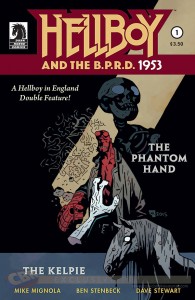 Hellboy and the B.P.R.D.: 1953 #1 — Writer: Mike Mignola; Art: Ben Stenbeck; Colors: Dave Stewart
Hellboy and the B.P.R.D.: 1953 #1 — Writer: Mike Mignola; Art: Ben Stenbeck; Colors: Dave Stewart
The Black Hand #6 — Writer: Duane Swierczynski; Art: Howard Chaykin; Colors: Jesus Aburto
Island #4 — Creators: Various
A handful of other indy books: Hellboy and the B.P.R.P.: 1953 is exactly that — two stories set in the title character’s early years with the Bureau, battling  the supernatural; considering how events in the present-day Mignolaverse are pretty much destroying both Earth and Hell, it’s nice to read these more small-scale ghost tales, especially given his skill as a writer, and Stenbeck’s ability to create the kind of dark, shadowy tone laced with humor that the book demands. Black Hand is worth noting because Howard Chaykin, with the added advantage that it’s a done-in-one story that requires no other knowledge of the character, while Island is Brandon Graham and
the supernatural; considering how events in the present-day Mignolaverse are pretty much destroying both Earth and Hell, it’s nice to read these more small-scale ghost tales, especially given his skill as a writer, and Stenbeck’s ability to create the kind of dark, shadowy tone laced with humor that the book demands. Black Hand is worth noting because Howard Chaykin, with the added advantage that it’s a done-in-one story that requires no other knowledge of the character, while Island is Brandon Graham and 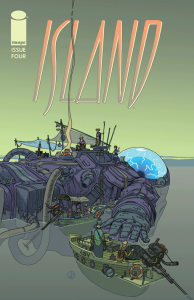 Emma Rios’s Heavy Metal-like, high-fantasy anthology series. For $7.99, you get 112 pages of beautiful production, so everyone gets lots of space to offer their work, and it all looks great: Graham himself has 23 pages, while indy star Faryl Dalrymple gets 53 pages for his Pop-Gun War; Gael Bertrand combines French, manga and American comics influences for 24 pages, and a couple of other creators check in too. This is one of those series offering young storytellers at the top of their games, and ten years from now we’ll all look back on it and talk about how ground-breaking and influential it was, so get it now and avoid the rush.
Emma Rios’s Heavy Metal-like, high-fantasy anthology series. For $7.99, you get 112 pages of beautiful production, so everyone gets lots of space to offer their work, and it all looks great: Graham himself has 23 pages, while indy star Faryl Dalrymple gets 53 pages for his Pop-Gun War; Gael Bertrand combines French, manga and American comics influences for 24 pages, and a couple of other creators check in too. This is one of those series offering young storytellers at the top of their games, and ten years from now we’ll all look back on it and talk about how ground-breaking and influential it was, so get it now and avoid the rush.



